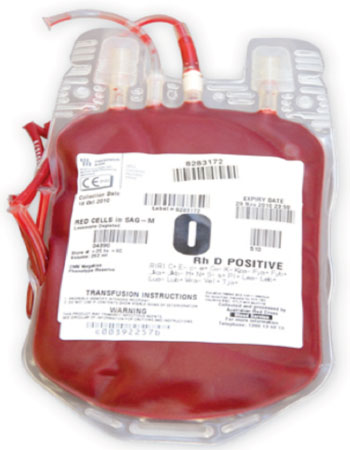Red Blood Cell Transfusion Benefits Analyzed for Trauma Patients
By LabMedica International staff writers
Posted on 02 Jul 2014
The risks and benefits of red blood cell transfusions for patients with trauma and major bleeding might vary considerably based on a patient's predicted risk of death on arrival at a trauma center.Posted on 02 Jul 2014
Trauma patients who have the highest predicted risk of death on arrival at a trauma center receive the greatest benefit from red blood cell transfusions, but for those with the lowest predicted risk of death at baseline red blood cell transfusion is associated with a higher chance of death.

Image: Red blood cell transfusion pack (Photo courtesy of Australian Red Cross).
Scientists at the London School of Hygiene and Tropical Medicine (UK) evaluated the association between receiving red blood cell (RBC) transfusion versus not receiving a RBC transfusion with deaths by all causes at 28 days post-trauma. The findings were stratified by predicted risk of death based on clinical observations on arrival at the trauma center. The investigators included 20,127 trauma patients with significant bleeding from 274 hospitals in 40 countries in their study.
The authors found that those at greatest predicted risk of dying, greater than 50%, had a smaller chance of death from all causes if they were transfused, while for those in the 21% to 50% risk group there was no significant difference in their chance of dying based on whether they are transfused or not. Patients at a 6% to 10% chance of death had a high odd ratio (OR) of 2.31 for dying if they received a transfusion, while for those whose initial risk was below 6%, the OR for death associated with transfusion was very high at 5.40. RBC transfusion was associated with 5.1 more deaths per 100 patients in the patient group with the lowest predicted risk of death but with 11.9 fewer deaths per 100 patients in the group with the highest predicted risk of death.
The authors concluded that although RBC transfusion might be life-saving for patients with hemorrhagic shock, uncertainty remains about the best early transfusion strategy in other patients. Their study suggests that blood transfusion could be harmful for those patients whose predicted risk of death is low. However, as the study was observational, important biases cannot be ruled out, and they do not claim a causal link.
Druin Burch, MD, a consulting editor of the journal, said, “With so many dying each year, and with deaths from injury set to rise in importance as road traffic crashes and violent injuries account for a greater portion of the global burden of disease, we have a compelling reason to improve and rationalize our transfusion strategies.” The study was published on June 17, 2014, in the journal Public Library of Science Medicine.
Related Links:
London School of Hygiene and Tropical Medicine













